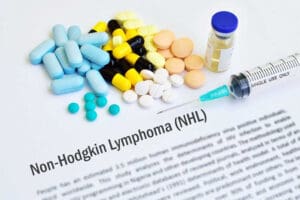Introduction
Roundup is the most popular brand among commercially available glyphosate-based weed killers. This type of herbicide uses glyphosate salt in combination with other chemicals to make it more readily absorbed by plants. Glyphosate-based herbicides are the most widely used weedkiller globally, with 6.1 billion of this solution sprayed on garden plants and crops from 2005 to 2014 alone.
However, a large cohort study in 2018 conducted by researchers from various institutions reported that glyphosate exposure is associated with human health problems and an increased risk of developing specific types of cancer. It indicated a cancer incidence rate of 79.3% or 5,779 cases of cancer from the 44,932 glyphosate-based chemical applicators, with myeloid leukemia the most common type of cancer recorded. In 2019, a University of Washington research team published a report showing a 41% higher risk of developing non-Hodgkin lymphoma due to glyphosate exposure.
How Does Roundup Cause Cancer?
The story of Roundup started in 1996 when the Roundup Ready Soybean was released by the Monsanto company. Roundup Ready is a genetically modified soybean that is resistant to glyphosate. Monsanto also developed glyphosate-resistant maize and cotton. These genetically modified crops contain glyphosate resistance genes from bacteria which all other plants – including weeds – lack. So, spraying a field with glyphosate kills only the weeds and not the crops.
How glyphosate works
Roundup is a systemic herbicide that targets weeds once they emerge from the soil. Its active ingredient is glyphosate which the Weed Science Society of America classifies as a Group 9 herbicide. The chemical name of glyphosate is N-(phosphonomethyl)glycine, providing clues about the chemical structure of this herbicide.
Glyphosate works by disrupting the amino acid synthesis in target plants by inhibiting an enzyme called EPSP synthase essential for plant growth. EPSP synthase is required to produce a number of amino acids, which are the basic components of proteins. Glyphosate is highly effective as an herbicide because it shuts down an important metabolic pathway in all plants by inhibiting EPSP synthase. Glyphosate binds strongly to the target site in the EPSP synthase molecule, rendering the enzyme completely nonfunctional.
Glyphosate uses
Glyphosate has been registered as a pesticide with the Environmental Protection Agency (EPA) since 1974. It is used to control a wide variety of broadleaf grasses and weeds. Some agricultural plants where glyphosate is used are corn, canola, sugarbeet, alfalfa, legumes, cereals, herbs and spices, and leafy vegetables. Glyphosate is also used for non-agricultural purposes, such as turfgrass, pastures, and residential areas.
Health effects of glyphosate
Non-Hodgkin lymphoma
EPA scientists have declared that glyphosate exposure poses no risks of concern to human health, adding that children are not especially sensitive to it. They also claim it does not cause endocrine disruption and does not cause cancer in humans.
However, there is compelling evidence from peer-reviewed studies linking glyphosate-based herbicides with increased risk of developing cancer, especially non-Hodgkin lymphoma. According to a meta-analysis done in 2019, glyphosate exposure is correlated with genetic alterations, endocrine disruption, and immunosuppression that are associated with non-Hodgkin lymphoma.
Breast cancer
Exposure to glyphosate has also been implicated in breast cancer development. A 2019 study found that glyphosate promotes cell proliferation by causing gene expression alteration in human breast cancer cells MCF-7 and MDA-MB-468. This disruption in gene expression was due to the deregulation of DNA damage repair, cell cycle, and nine other canonical pathways. Metabolic pathways are also affected by Roundup through hypoxia induction, reactive oxygen species increase, and modified mitochondrial oxygen consumption.
Neurological effects
In addition to the aforementioned cytotoxic and genotoxic effects, glyphosate exposure has also been observed to play a role in cerebral impairment. Neurologic effects of glyphosate are attributed to this chemical’s ability to cross the blood-brain barrier. Exposure to glyphosate has resulted in some cases of aseptic meningitis and vasculitic neuropathy. Glyphosate-based sprays have also been found to impact learning and locomotion due to disruption of the dopaminergic pathway, as well as memory formation through modification of the acetylcholine esterase activity.
Liver complications
In patients with fatty liver disease, glyphosate can increase the risk of developing steatohepatitis and advanced liver fibrosis. This complication is due to elevated glyphosate excretion in patients with fatty liver disease compared to individuals without the liver condition. According to the authors of the report, the possible mechanism behind this effect is disruption of the mitochondrial oxidative phosphorylation in the liver. Another potential cause is inhibition of fatty acid oxidation and accumulation of cholesteryl ester in the liver.
Congenital disabilities
Furthermore, glyphosate has been reported to cause pregnancy problems and congenital disabilities. Pregnant women exposed to glyphosate and its derivative called aminomethylphosphonic acid have been reported to suffer an increased risk of preterm birth. The 2021 cohort study in Puerto Rico found that exposure at the 26th week of pregnancy to glyphosate and aminomethylphosphonic acid increased the risk of preterm birth due to the induction of oxidative stress. A study in Argentina published in 2018 linked exposure to glyphosate with increased risk of congenital abnormalities and spontaneous abortion. The authors reported that congenital abnormalities and spontaneous abortion were higher than the national average. Potential mechanisms behind the birth problems include DNA and cell damage, given the published cytotoxic and genotoxic effects of glyphosate.
Are There Regulations That Protect Humans From Roundup?
To protect the public from the detrimental health effects of glyphosate, governments and international agencies like the World Health Organization have developed guidelines and regulations for the proper use of glyphosate-based products. These include setting up maximum glyphosate intake limits and management measures for the use of herbicides in residential areas and farms. These are important considerations in light of the information regarding glyphosate’s potential to cause cancer and other risk factors.
Glyphosate cRfD and ADI
To limit exposure of the public to glyphosate, the United States EPA has set the chronic reference dose (cRfD) for glyphosate at 1.75 mg/kg/day. The European Union (EU) uses a different terminology called acceptable daily intake (ADI) for the same purpose. The EU’s ADI for glyphosate is 0.3 mg/kg/day, which is almost six times lower than the cRfD set by EPA. The cRfD determines the concentration of a particular substance that an individual could consume daily for an extended period without any substantial risk of a detrimental effect. ADI’s definition is essentially the same as that of cRfD.
ADI and cRfD have been used by EU and EPA, respectively to evaluate systemic effects of substances on the human body. Systemic effects are caused by systemic toxicants, which are chemicals that impact the function of different organ systems. Gene mutation and cancer-causing chemicals also cause systemic toxicity. It is assumed that systemic toxicity has an exposure threshold and that below this threshold, no identifiable deleterious effect is expected, which is the basis of cRfD and ADI.
Cancer-causing glyphosate level
Peer-reviewed studies have attempted to determine the glyphosate level that can cause the formation of tumors in experimental mice since this cannot be performed on humans. Four studies from 1983 to 2009 investigated the effect of different doses of glyphosate on mice for 18 to 24 months and the resulting incidence of the rate of three different types of cancer. Renal tumors started to appear in mice treated with 100 mg/kg body weight per day of glyphosate for 24 months. On the other hand, malignant lymphoma and hemangiosarcoma tumors were detected in mice given 71 mg/kg body weight per day of glyphosate for 18 months in the said animal studies.
For reference, a 2021 study has shown that American exposure to glyphosate through dietary intake ranged from 38 ug/day to 1,100 ug/day. However, there are studies that indicate increasing levels of glyphosate and its residues in people’s urine samples. More importantly, the tested individuals in the dietary study are not gardeners and farmers who regularly use Roundup and other glyphosate weed killers. Agricultural and residential herbicide applicators are exposed to glyphosate several times more than the average individual.
What are Safer Alternatives to Roundup?
With the mounting health concerns against Roundup and other glyphosate-based weed killers, it is understandable for people to look for ways to avoid exposure to glyphosate and lower cancer risk, including non-Hodgkin lymphoma. There are various methods to control weeds in gardens and crop farms that are safer for applicators and consumers to limit chronic exposure to glyphosate. The following are safe alternatives to using Roundup and other glyphosate-based herbicides.
Roundup Alternatives
The first group of alternatives is commercial herbicides that do not contain glyphosate, Roundup’s active ingredient. Examples of non-glyphosate weed killers include glufosinate, pelargonic acid, and diquat. These three weed-killing active ingredients are available in the market as various brands.
Glufosinate is a non-selective, locally systemic, post-emergence herbicide. It effectively eliminates annual weeds and nutsedges but not against perennial weeds such as bermudagrass and goldenrod.
Pelargonic acid is a contact; a post-emergence herbicide often referred to as “herbicidal soap.” It is a fast-acting herbicide but is not specific to weeds, and commercial brands are costly.
Diquat is also contact, post-emergence weed killer. It is effective against small annual weeds but not on perennial weeds and large annual weeds. It is a fast-acting and cheaper alternative to other commercial herbicides.
The next group is”natural” weed killers such as vinegar and botanical oils. Vinegar is one common ingredient that is often mentioned as an alternative to glyphosate. Vinegar is also known as acetic acid or ethanoic acid. Herbicidal vinegar, however, is different from household vinegar because the former has two to four times the acetic acid content of regular vinegar. When sprayed sufficiently, herbicidal vinegar can rapidly burn down plants that are under strong sunlight exposure. It requires the addition of a sticking agent such as yucca extract. It is quite effective against broadleaf weeds but produces a pungent smell, can cause skin and eye irritation and requires multiple applications for perennial and larger weeds.
Botanical oils that are usually used as weed killers include di-limonene, eugenol, and clove oil. Examples of such herbicides that are available in the market include EcoSmart Weed and Grass Killer, Bioganic Broadleaf Killer, and WeedZap. These natural weed killers are fast-acting but only kill the green portions of plants and do not reach the roots of weeds, thus only providing short-term weed control. They can, nevertheless, be effective against small annual weeds.
Another plant-based weed killer is corn gluten meal which is a pre-emergent weed killer. It is claimed to be effective against germinating weeds. It works by preventing weeds such as crabgrass from developing roots. However, corn gluten is costly and application of this weed killer requires the right timing to be effective.
How to Protect against Roundup
To be safe from the effects of Roundup such as developing non-Hodgkin lymphoma in areas where the residents use the weed killer heavily, the following measures can be taken:
Avoiding recently sprayed areas
Croplands, grass parks, and gardens are often sprayed with weed killers, so these places should be avoided if possible. When a neighbor is treating their house and lawn with glyphosate-based weed killers, staying at home and closing the doors and windows can prevent exposure.
Wearing protective clothing
In farm or residential areas where Roundup is regularly sprayed, the wearing of protective clothing can prevent exposure to glyphosate. Long-sleeved shirts, long pants, and shoes with socks can help shield wearers from making contact with glyphosate. Research shows glyphosate exposure typically occurs through contact with skin, so reducing exposed areas lowers the odds of getting directly splashed or sprayed on with Roundup.
Washing hands
Surface areas near farms accumulate glyphosate-based herbicide residues. So, it is advisable not to touch such surfaces areas if possible. It is also best to wear gloves. Research demonstrates washing of hands regularly can significantly reduce the odds of glyphosate contamination. When handling herbicide-contaminated items, wearing gloves can lower the risk of exposure.
Avoiding glyphosate-treated vegetables and fruits
Around farms where Roundup is frequently used, it is best to avoid eating locally grown plant food products. If possible, it is better to eat “organic” food since these do not contain herbicides and synthetic fertilizer residues. If organic-free foods are not available, then pesticide-free food should be consumed. Genetically modified plants such as Roundup Ready vegetables are sure to contain glyphosate, so these should be avoided.
Monitoring glyphosate levels in the body
Glyphosate, Roundup’s active ingredient, can be absorbed by the body in several ways, so people living near farms and glyphosate use-heavy locations should make it a point to check their bodies’ glyphosate levels. This can help people make more informed decisions regarding their lifestyles and how to reduce or remove their toxin load.
Eating sulfur-rich foods
People exposed to glyphosate can suffer from sulfur depletion. Thus, eating cheese, eggs, garlic, and onion can help the body maintain a healthy amount of sulfur.
Taking manganese supplement
Glyphosate in the body can bind to specific minerals since it is a strong chelating agent. Manganese is one of the essential minerals that glyphosate binds with. Manganese deficiency can result in severe neurologic, digestive, and cellular damage, so taking supplements can help maintain appropriate manganese levels.
Takeaway Points
Roundup is a popular herbicide that is used around the world. This means that this chemical could be everywhere, in the air, and even on surfaces of frequently visited places and in plant food products, so it is a public health concern. People who regularly use Roundup, such as those who maintain gardens, turfgrass, and farms, are at a higher risk of developing cancer and other health problems. This is because glyphosate has been found to increase cancer risk, according to an extensive body of research.
Glyphosate exposure has been associated with an increased risk of developing non-Hodgkin lymphoma, myeloid leukemia, and breast cancer in humans and renal cancer, malignant lymphoma, and hemangiosarcoma in laboratory mice.
Glyphosate exposure also increases the risk factors of developing neurological problems, liver complications, and congenital disabilities. To reduce these risk factors, people should explore alternatives to glyphosate, such as natural herbicides. It is also best to take steps against the dangers of glyphosate, such as avoiding contaminated areas, wearing protective clothes, washing hands, and eating organic food.
It is important to be vigilant about the health effects of Roundup on your family and community. If you suspect that you have developed cancer such as non-Hodgkin lymphoma due to exposure to Roundup, it is advisable to seek legal counsel about a potential lawsuit.
Who can File a Lawsuit?
Individuals who develop cancer, such as non-Hodgkin lymphoma, can consider contacting legal counsel for filing a mass tort lawsuit. They can discuss with a mass tort attorney what is a Roundup case and if they are eligible to seek financial damage. Receiving a cancer diagnosis is an extremely difficult experience for anyone. The prospect of losing wages and facing mounting medical bills is a challenging psychological weight that victims should not face alone. If you are in this position due to occupational exposure, you might have a legal claim and should hold Monsanto, the maker of Roundup, responsible for this financial burden.




